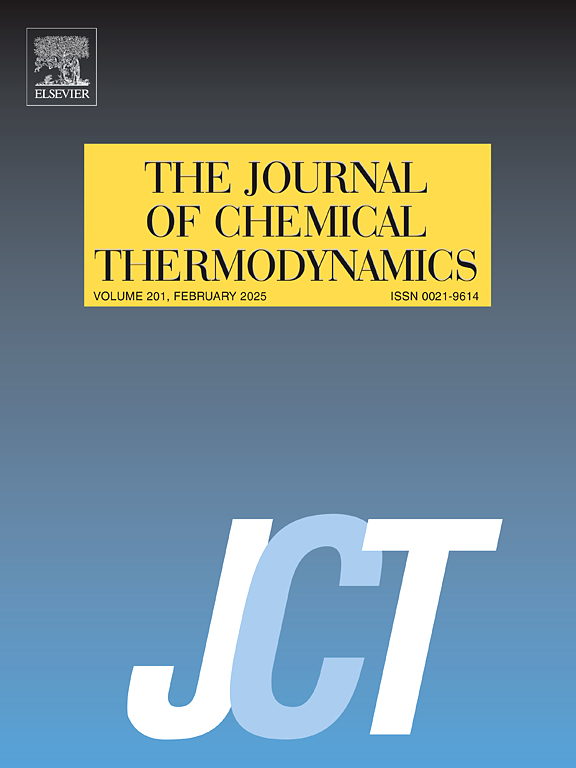不同萃取剂分离环己烷+异丙醇体系液液平衡数据的测定及相关性研究
IF 2.2
3区 工程技术
Q3 CHEMISTRY, PHYSICAL
引用次数: 0
摘要
本研究确定了乙二醇(EG)、甲酰胺和1,2 -丙二醇作为分离环己烷+异丙醇(IPA)共沸体系的萃取剂。采用Materials Studio的Dmol3模块对萃取剂的σ-谱进行了分析,并计算了各组分之间的相互作用能,结果表明EG是最有前途的萃取剂。在303.15 K、313.15 K和323.15 K下,测定了环己烷+ IPA +萃取剂体系的液液平衡(LLE)数据。随着温度的升高,EG和甲酰胺的提取率降低。同时,温度对1,2 -丙二醇的容量影响较小。EG的分布系数(D)和分离因子(S)值较高,表明其具有较好的分离效果。使用other - tobias和Hand方程来估计LLE数据的可靠性和一致性。利用Aspen Plus 11软件中的非随机双液体(NRTL)和通用准化学(UNIQUAC)热力学模型对LLE数据进行回归,计算二元相互作用参数。均方根偏差(RMSD)值均小于0.02,表明NRTL和UNIQUAC模型能较好地关联实验数据。最后,利用GUI-MATLAB软件对回归的二元交互参数进行进一步验证,验证了数据回归的可靠性。本文章由计算机程序翻译,如有差异,请以英文原文为准。
Determination and correlation of liquid-liquid equilibrium data for separation of cyclohexane + isopropyl alcohol systems with different extractants
In this work, ethylene glycol (EG), formamide, and 1, 2-propanediol were identified as potential extractants for separating cyclohexane + isopropanol (IPA) azeotropic system. The σ-profile was analyzed using the Dmol3 module of Materials Studio, and the interaction energy between the components was calculated, indicating that EG is the most promising extractant. The liquid-liquid equilibrium (LLE) data for the cyclohexane + IPA + extractants system were measured at 303.15 K, 313.15 K and 323.15 K. When the temperature increases, the extraction capacities of EG and formamide decrease. Meanwhile, the temperature has less impact on the capacity of 1, 2-propanediol. EG has higher value of the distribution coefficient (D) and separation factor (S), indicating its superior effectiveness for separation. Othmer-Tobias and Hand equations were used to estimate the reliability and consistency of the LLE data. The nonrandom two-liquid (NRTL) and universal quasi-chemical (UNIQUAC) thermodynamic model in Aspen Plus 11 software were used to regress the LLE data, and the binary interaction parameters were calculated. The root mean square deviation (RMSD) values were all less than 0.02, indicating that the NRTL and UNIQUAC models can correlate experimental data well. Finally, the regressed binary interaction parameters were further validated using GUI-MATLAB software, confirming the reliability of the data regression.
求助全文
通过发布文献求助,成功后即可免费获取论文全文。
去求助
来源期刊

Journal of Chemical Thermodynamics
工程技术-热力学
CiteScore
5.60
自引率
15.40%
发文量
199
审稿时长
79 days
期刊介绍:
The Journal of Chemical Thermodynamics exists primarily for dissemination of significant new knowledge in experimental equilibrium thermodynamics and transport properties of chemical systems. The defining attributes of The Journal are the quality and relevance of the papers published.
The Journal publishes work relating to gases, liquids, solids, polymers, mixtures, solutions and interfaces. Studies on systems with variability, such as biological or bio-based materials, gas hydrates, among others, will also be considered provided these are well characterized and reproducible where possible. Experimental methods should be described in sufficient detail to allow critical assessment of the accuracy claimed.
Authors are encouraged to provide physical or chemical interpretations of the results. Articles can contain modelling sections providing representations of data or molecular insights into the properties or transformations studied. Theoretical papers on chemical thermodynamics using molecular theory or modelling are also considered.
The Journal welcomes review articles in the field of chemical thermodynamics but prospective authors should first consult one of the Editors concerning the suitability of the proposed review.
Contributions of a routine nature or reporting on uncharacterised materials are not accepted.
 求助内容:
求助内容: 应助结果提醒方式:
应助结果提醒方式:


